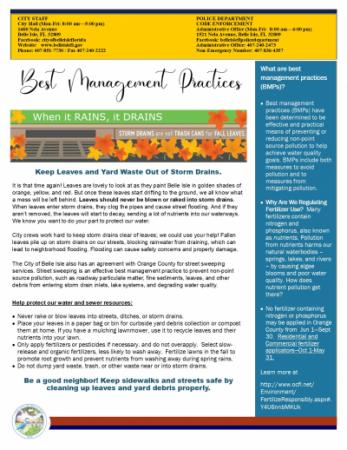Best Management Practices: Keep Leaves and Yard Waste Out of Storm Drains
Keep Leaves and Yard Waste Out of Storm Drains.
It is that time again! Leaves are lovely to look at as they paint Belle Isle in golden shades of orange, yellow, and red. But once these leaves start drifting to the ground, we all know what a mess will be left behind. Leaves should never be blown or raked into storm drains. When leaves enter storm drains, they clog the pipes and cause street flooding. And if they aren’t removed, the leaves will start to decay, sending a lot of nutrients into our waterways. We know you want to do your part to protect our water.
City crews work hard to keep storm drains clear of leaves; we could use your help! Fallen leaves pile up on storm drains on our streets, blocking rainwater from draining, which can lead to neighborhood flooding. Flooding can cause safety concerns and property damage.
The City of Belle Isle also has an agreement with Orange County for street sweeping services. Street sweeping is an effective best management practice to prevent non-point source pollution, such as roadway particulate matter, fine sediments, leaves, and other debris, from entering storm drain inlets and lake systems and degrading water quality.
Help protect our water and sewer resources:
- Never rake or blow leaves into streets, ditches, or storm drains.
- Place your leaves in a paper bag or bin for curbside yard debris collection, or compost them at home. If you have a mulching lawnmower, use it to recycle leaves and their nutrients into your lawn.
- Only apply fertilizers or pesticides if necessary, and do not overapply. Select slow-release and organic fertilizers, which are less likely to wash away. Fertilize lawns in the fall to promote root growth and prevent nutrients from washing away during spring rains.
- Do not dump yard waste, trash, or other waste near or into storm drains.
Be a good neighbor! Keep sidewalks and streets safe by cleaning up leaves and yard debris properly.
----------------------------------------------------
What are best management practices (BMPs)?
Best management practices (BMPs) have been determined to be effective and practical means of preventing or reducing non-point source pollution to help achieve water quality goals. BMPs include both measures to avoid pollution and to mitigate pollution.
- Why Are We Regulating Fertilizer Use? Many fertilizers contain nitrogen and phosphorus, also known as nutrients. Pollution from nutrients harms our natural waterbodies – springs, lakes, and rivers – by causing algae blooms and poor water quality. How does nutrient pollution get there?
- No nitrogen or phosphorus fertilizer may be applied in Orange County from June 1 to Sept 30. Residential and Commercial fertilizer applicators—Oct 1-May 31.
- Learn more at http://www.ocfl.net/Environment/FertilizeResponsibly.aspx#.Y4U6nnbMKUk

